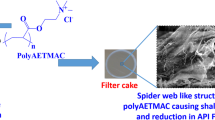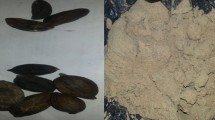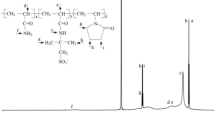Abstract
Drilling fluids are designed to assist drilling by minimizing reservoir damage and increasing productivity of pay zone. Excess fluid loss due to degradation of additives of drilling fluids causes a major problem in real-time drilling. Usages of excess biocides are threat to the environment and cause handling problems. Effect of cetyltrimethylammoniumbromide, a cationic surfactant, on rheology, fluid loss and biocide has been studied in a polymer-based drilling fluid. Inhibitive polymer mud was formulated using XC polymer, shale inhibitors like KCl, K2SO4 and CaCO3 as bridging agent. Rheology and other properties were studied using Fann VG meter, API filter press, mud balance, roller oven apparatus. Dissolved oxygen meter was used to check the microbicidal property of cetyltrimethylammoniumbromide. Addition of cetyltrimethylammoniumbromide increased fluid retention capacity of the fluid even at very low concentration 0.1%(w/v) without affecting the mud properties. Also it is compatible with the commercially available fluid loss preventers like pre-gelatinized starch when used in combination. It also performed well in dissolved oxygen test, suggesting eliminating need of any other biocide to prevent degradation of bio-polymer-based drilling fluid. The dissolved oxygen test results are comparable with commercial available biocides. Thermal stability studies were carried out by using roller oven at different temperatures. It was found suitable for application in high-concentrated brine conditions and at high temperatures up to 120 °C without effecting the rheology and shear thinning property of the fluid. Bridging efficiency was investigated by analysing the mud cake using scanning electron microscope.
Similar content being viewed by others
Avoid common mistakes on your manuscript.
Introduction
Drilling fluids are designed to assist the oil and gas exploration process and production by stabilizing the wellbore. During drilling, hydraulic head exerts a pressure on fluid and minimal filtrate separates by forming a thin filter cake on wellbore and thus stabilizes the wellbore. Excess of fluid loss destabilizes the wellbore and results in the stuck pipe, and wellbore collapses apart from damaging the pay zone. Performance of the drilling fluids in a particular operating condition is rated in terms of rheology and with fluid loss (Briscoe et al. 1994; Cameron 2001; Omland et al. 2008). Polymer-based drilling fluids have emerged as high-performance water-based drilling fluids (WBM) by showing performance comparable to oil-based mud. Polymer-based drilling fluids are used to drill pay zones, horizontal and multilateral wells due to the clean and minimum formation damage property. Polymer mud formulated with KCl, xanthan gum, starch and PAC-LV shows an improved hole cleaning and hole stability property (Simonides et al. 2002; Kjosnes et al. 2003; Patel et al. 2007). Xanthan gum has got unique rheological properties, such as high low-shear viscosity and strong shear thinning character in the solution. Polymer mud comprising of calcium carbonate acts as a weighting and bridging agent (Zitha 1997; Dick et al. 2000), whereas polymers such as starch and xanthan provide appropriate rheological properties to the mud. Such mud forms filter cakes, which is a supra-molecular complex, containing carbonate, polymers and rock fines arising from drilling (Cobianco et al. 2001). When drilling through the high-permeable formations, addition of different sized calcium carbonates blended to increase mud weight in mixture of salt and polymer-based mud is recommended (Marin et al. 2009).
Formation of supra-molecular complexes are influenced by both electrostatic interactions between charged components and hydrophobic interactions between the polymer backbone and the alkyl chain of surfactant (Wang et al. 2004; Starodubtsev et al. 2004; Xin et al. 2007). The macroscopic properties of the mixture depend on the type of polyelectrolyte and surfactant selected, but also depends on the environmental factors of system (Xin et al. 2007). Hexadecyl-trimethyl-ammonium bromide or cetyltrimethylammoniumbromide (CTAB)-based viscoelastic surfactant systems show shear sensitivity property. Controlling the degree of reassembling by using viscoelastic surfactants maximizes performance of the surfactant system for different applications (Lee et al. 2003).
CTAB along with sorbitan monooleate has been used as fluid loss control additive for preventing the fluid invasion into the porous pristine formation and avoiding the collapse of borehole wall in oil-drilling excavation (Fan et al. 2014) in montmorillonite-based drilling fluid. In general, surfactants significantly reduce the coefficient of friction independently of the weighting materials used and that formulation has a superior performance in coefficient of friction reduction than diesel-based formulation without affecting the rheology of the mud (Gonzaleza et al. 2011).
Drilling into deeper formation requires drilling fluids that withstand higher temperatures and pressures. The combined pressure–temperature effect on drilling fluid’s rheology is complex. This provides a wide range of difficult challenges and mechanical issues. This can have negative impact on rheological properties when exposed to high-pressure and high-temperature (HPHT) condition and contaminated with other minerals, which are common in deep drilling. High-pressure and high-temperature (HPHT) wells have bottom hole temperatures of 300 °F (150 °C) and bottom hole pressures of 10,000 psi (69 MPa) or higher (Saito et al. 1998, Saito and Sakuma 2000; Kjosnes et al. 2003). Present work is aimed to study the effect of CTAB, a cationic surfactant, on control fluid loss, other biocide use elimination, improvement in rheological property and thermal stability of a polymer drilling fluid.
Experimental
Materials
CTAB (≥98.0 assay) was purchased from Sigma-Aldrich Chemicals. All the mud chemicals used in the experiment are drilling grade chemicals. XC polymer, KCl, pre-gelatinized starch (PGS) were procured from Gumpro fluids. Micronized calcium carbonate, K2SO4 and EP Lube were procured from Petropath fluids.
Methods
Fourier transform infrared spectroscopy (FTIR) measurements
FTIR spectra of CTAB were recorded on PerkinElmer Spectrum 2 (software: version 10.4.2); 2 mg CTAB and 200 mg KBr were fully blended. The mixture was kept into the mould and pressurized to 20 MPa by using hydraulic press to prepare pellet for the analysis.
Preparation of the base mud-1
Drilling fluid system was formulated using the following chemicals. The addition sequence of the chemicals follows the below given order. Additives used in the base mud-1, base mud-2 formulation and its functions are shown in Tables 1 and 2, respectively.
Analysing fluid property
Mud rheology was measured using Fann VG meter at 600, 300, 6 and 3 rpm as per API protocols.
Plastic viscosity (PV) = 600 rpm − 300 rpm, (cP); yield point (YP), = 300 rpm − PV, (lbs/100 sq.ft). OFITE fluid loss apparatus was used to study the fluid loss controlling property of CTAB. API fluid loss test was carried out for 30 min under a pressure of 100 psi and temperature 25 °C. Mud weight was measured using calibrated OFITE mud balance.
Mud weight was measured using calibrated OFITE mud balance. High-temperature stability study was carried out using OFITE roller oven. Mud was hot rolled at four different temperatures 80, 90, 100 and 120 °C for 16 h. After hot rolling, mud was cooled to room temperature and stirred for 20 min using Hamilton Beach mixer. After stirring, mud was subjected to the analysis of rheology, fluid loss and mud weight by following API test procedures (API 2003).
Dissolved oxygen analyzer
Biocide property of CTAB was determined by measuring dissolved oxygen (DO) of water sample. DO measured using Thermo scientific manufactured EUTECH PCD 650 multiparameter. Instrument was calibrated before performing DO analysis. Calibration has been done using two standard ranges of 0 and 100% oxygen level.
Scanning electron microscopy (SEM) and energy-dispersive X-ray spectroscopy (EDX)
Mud cakes were analysed using ZEIZZ, ULTRATM55. Mud cake sample was dispersed in ethanol and coated on carbon tape and dried. Sample was sputtered using gold/palladium (Au/Pd) sputter and (Leica EM, ACE-200) coater. Argon was used as inert gas source for coating sample to a depth of 3 nm.
Result and discussion
FTIR characterization of CTAB
Characteristic peaks of FTIR spectrum for CTAB and functional group are shown in Fig. 1 and Table 3.
Biocide property of CTAB
Biocide property was investigated using DO analyzer. Test results shown in Table 4 were comparable with the commercial biocide such as formaldehyde. Results show that at higher concentration it also acts as biocide and prevents or retards the bacterial degradation.
Performance analysis of CTAB in drilling fluid
CTAB showed fluid loss controlling property at very low concentration of 0.1%(w/v) by decreasing 31.8% of the fluid loss. Cake formed during the filtration test is very thin <1 mm. Addition of more amount of CTAB increased the foam in the drilling fluid. In order to avoid the excess foaming, concentration of CTAB was optimized to maximum of 0.5%(w/v). At optimum concentration of 0.5%(w/v), CTAB as such shows an effect of nearly 40% reduction in the fluid loss. Final pH of the mud is maintained in the range of 9.5–10.0. Experimental results are given in Table 5.
Results of CTAB in KCl-inhibited mud showed that it acts as an effective fluid loss controlling agent. Detailed study is carried out by using it in combination with commercially available fluid loss controlling fluid loss additive PGS.
CTAB used in combination with PGS mud showed very good fluid loss controlling property by forming very thin filter cake. When 0.5%(w/v) of PGS was used, decrease in fluid loss was very less compare to effect of CTAB. When CTAB and PGS were used in combination by keeping concentration of PGS to 0.5%(w/v), it was observed that as the concentration of CTAB varies from 0.1 to 0.5%(w/v), fluid loss decreased from 14.8 to 5.2 cc. To avoid the excess foaming, the optimal concentration of CTAB was maintained 0.5%(w/v).
From the results, it could be inferred that the CTAB was effective in high-salt condition such as 10.0%(w/v) KCl, without altering the rheology and shear thinning property of the mud. Test results are shown in Table 6.
Salt tolerance property of CTAB was further investigated in 10%(w/v) K2SO4. Experimental results are similar to the KCl system with a marginal variation of fluid loss at optimum concentration. Excellent fluid loss control of 5.4 cc observed at a concentration 0.5%(w/v) of CTAB and PGS as shown in Table 7.
Characterization of mud cake
Mud cake was characterized using scanning electron microscope. The SEM micrograph of CTAB-treated XCP mud cake and XCP mud cake (without CTAB), Figs. 3 and 2, respectively, showed distinct difference. CTAB caused dispersion, of the solids, thereby increasing the packing density and reducing water loss (Tables 8, 9, 10).
Thermal stability of mud
Thermal stability studies were carried up to 120 °C, and results show that CTAB is thermally stable. Above 120 °C, polymer used in the formulation is not stable. Xanthan gum starts to lose its property above 120 °C due to hydrolytic and oxidative processes (Lambert 1985). Therefore, the maximum thermal stability ascertained for the formulation was 120 °C. Experimental results showed that CTAB gave better thermal stability property. Marginal change in fluid loss was observed when temperature increased from 100 to 120 °C. This might have been due to the instability of XCP at 120 °C. The overall increase in fluid loss observed was around 1.8 cc in comparison with the BHR mud. Thermal stability results showed that the mud was stable up to 120 °C. Experimental results are shown in the chart Figs. 4, 5 and 6.
Enhanced thermal stability was observed when PGS was used in combination with CTAB. Thermal stability study of PGS and CTAB mud was observed up to 100 °C. Above 100 °C, starch was not stable. CTAB used in combination with PGS in KCl-inhibited and K2SO4-inhibited mud similar trends was observed. Marginal change at 100 °C was observed. The change in the fluid loss was observed in both the mud systems, which was around 1.0 cc, compared to BHR mud. It could be inferred from the above results that the system was stable up to 100 °C, and increase in water loss by 1.0 cc can be ignored (Figs. 7, 8, 9, 10, 11, 12).
Conclusion
CTAB a cationic surfactant was characterized using FTIR to determine the functional groups. Performance study of CTAB was studied using it in two different types of inhibited polymer mud systems. Inhibited polymer systems were prepared by using salts like KCl and K2SO4. CTAB was treated with polymer systems with a concentration ranging from 0.1 to 0.5%(w/v). Excellent fluid loss controlling property was observed on treating CTAB with the polymer mud. CTAB is also compatible with the PGS and enhanced the fluid loss control property of the fluid. It also acted as dispersant in the polymer mud. On addition of CTAB to the fluid, shear thinning property of the fluid is unaltered and fluid is uniformly dispersed in the presence of solids. Biocide property of CTAB is comparable with the commercial biocides like formaldehyde which is generally used for the polymer mud formulation. The presence of CTAB prevents the degradation of the polymers like PGS and decreases the fluid loss due to bacterial degradation. Thermal stability tests were conducted at different temperatures by hot rolling techniques. Stable rheology and shear thinning property of fluid were observed during the analysis after hot rolling. Excellent fluid loss controlling property of CTAB was confirmed as the additive was stable and retention of the fluid was similar to that of mud before hot rolling. Thermal stability results show that the fluid is stable up to 120 °C and can be utilized for the bottom hole temperature of 120 °C (Fig. 13).
It may be concluded that CTAB having a long-chain alkyl chain is linked to the anionic polymers through cationic ammonium head and increased the fluid retention capacity and thermal stability in inhibitive and dispersed mud system. CTAB is a multipurpose additive in the drilling fluids, and in optimal doses it can have multifunctional role as:
-
(1)
Dispersant maintains the rheology and thixotropy
-
(2)
fluid loss controller
-
(3)
biocide, eliminating the use of additional additive
-
(4)
thermal stabilizer may be used with HPHT mud systems
In combination with PGS in inhibited salt water system, fluid loss controlling property is enhanced. Mud formulation can be tailor made by increasing the concentration of XCP, MCC, KCl and K2SO4 for higher rheology and mud weight. CTAB can also be used for high-solid mud systems. It is a potential candidate as a common additive in drilling fluid formulations. High thermal stability of CTAB shows that it has got scope to use in HPHT mud formulations.
References
American Petroleum Institute (2003) Recommended practice for field testing of water-based drilling fluids, 3rd edn. American Petroleum Institute (82 pages ANSI/API 13B-1)
Briscoe BJ, Luckham PF, Ren SR (1994) The properties of drilling muds at high-pressures and high-temperatures. Philos Trans R Soc Lond Series A 348:179–207
Cameron C (2001) Drilling fluid design and management for extended reach drilling.In: IADC/SPE-72290, IADC/SPE middle east drilling technology conference, Bahrain, 22–24 Oct
Cobianco S, Bartosek M, Lezzi A, Guarneri A (2001) How to manage drill-in fluid composition to minimize fluid losses during drilling operations. SPEDC 16(3):154–158
Dick MA, Heinz TJ, Svoboda CF, Aston M (2000) Optimizing the selection of bridging particles for reservoir drilling fluids, SPE-58793
Fan J, Zhu H, Li R, Chen N (2014) Montmorillonite modified by cationic and nonionic surfactants as high-performance fluid-loss-control additive in oil-based drilling fluids. J Dispers Sci Technol 36:569–576
Gonzaleza JM, Quinteroa F, Arellanoa JE, Marquezb RL, Sanchezc C, Perniaa D (2011) Effects of interactions between solids and surfactants on the tribological properties of water-based drilling fluids. J Coll Surf Physicochem Eng Asp 391:216–223
Kjosnes I, Loklinghol G, Sasen A (2003) Successful water based drilling fluid design for optimizing hole cleaning and hole stability. SPE/IADC, 85330
Lambert F (1985) On the thermal stability of xanthan gum. Polymer 26:1549
Lee J, Nelson E, England K, Sullivan P (2003) Methods for controlling the rheological properties of viscoelastic surfactants based fluids. US 20030134751A1
Marin JU, Shah F, Searrao MA (2009) First deepwater well successfully drilled in Columbia with a high performance water based drilling fluid. In: SPE 120768
Omland TH, Dahl B, Saasen A, Taugbol K, Amundsen PA (2008) Optimized solid control provides opportunities for drilling depleted reservoirs. J Pet Technol 60:84–86
Patel A, Young S, Friedheim J (2007) Advances in inhibitive water based drilling fluids—can they replace oil based muds? SPE 106476
Saito S, Sakuma S (2000) Frontier geothermal drilling operations succeed at 500 °C BHST. SPE Drill Complet 15:152–161
Saito S, Sakuma S, Uchida T (1998) Drilling procedures, techniques and test results for a 3.7 km deep, 500 °C exploration well, Kakkonda, Japan. Geothermics 27:573–590
Simonides H, Schuringa G, Ghalambor A (2002) Role of starch in designing nondamaging completion and drilling fluids. In: SPE 73768
Starodubtsev SG, Dembo AT, Dembo KA (2004) Effect of polymer charge density and ionic strength on the formation of complexes between sodium arylamido-2-methyl-1-propane-sulfonate-co-acrylamide gels and cetyl pyridinium chloride. Langmuir 20:6599–6604
Wang X, Wang J, Wang Y, Yan H (2004) Salt effect on the complex formation between cationic Gemini surfactant and anionic polyelectrolyte in aqueous solution. Langmuir 20:9014–9018
Xin X, Xu GY, Wu D, Li YM, Cao XR (2007) The effect of CaCl2 on the interaction between hydrolyzed polyacrylamide and sodium stearate: rheological property study. Coll Surf A305:138–144
Zitha PLJ (1997) Water control by bridging colloids. In: European formation damage conference, SPE 38198
Acknowledgements
The authors would like to acknowledge Petropath Fluids (India) Pvt. Ltd., Gujarat, India, and Gumpro drilling fluids Pvt. Ltd., India, for the support received towards research.
Author information
Authors and Affiliations
Corresponding author
Rights and permissions
Open Access This article is distributed under the terms of the Creative Commons Attribution 4.0 International License (http://creativecommons.org/licenses/by/4.0/), which permits unrestricted use, distribution, and reproduction in any medium, provided you give appropriate credit to the original author(s) and the source, provide a link to the Creative Commons license, and indicate if changes were made.
About this article
Cite this article
Shettigar, R.R., Misra, N.M. & Patel, K. Cationic surfactant (CTAB) a multipurpose additive in polymer-based drilling fluids. J Petrol Explor Prod Technol 8, 597–606 (2018). https://doi.org/10.1007/s13202-017-0357-8
Received:
Accepted:
Published:
Issue Date:
DOI: https://doi.org/10.1007/s13202-017-0357-8

















